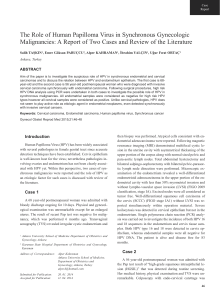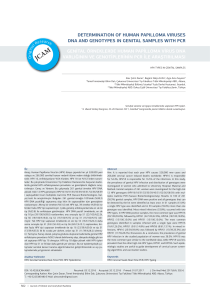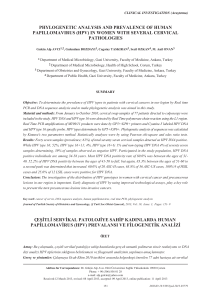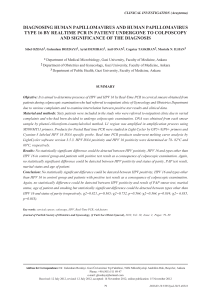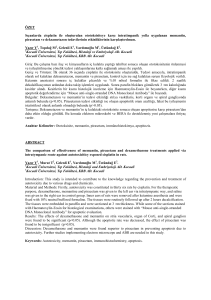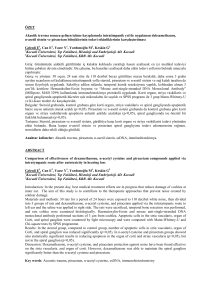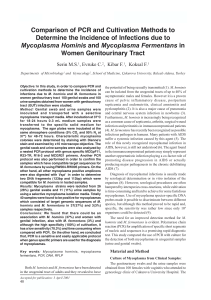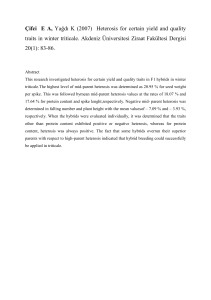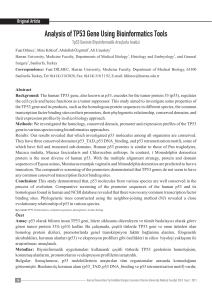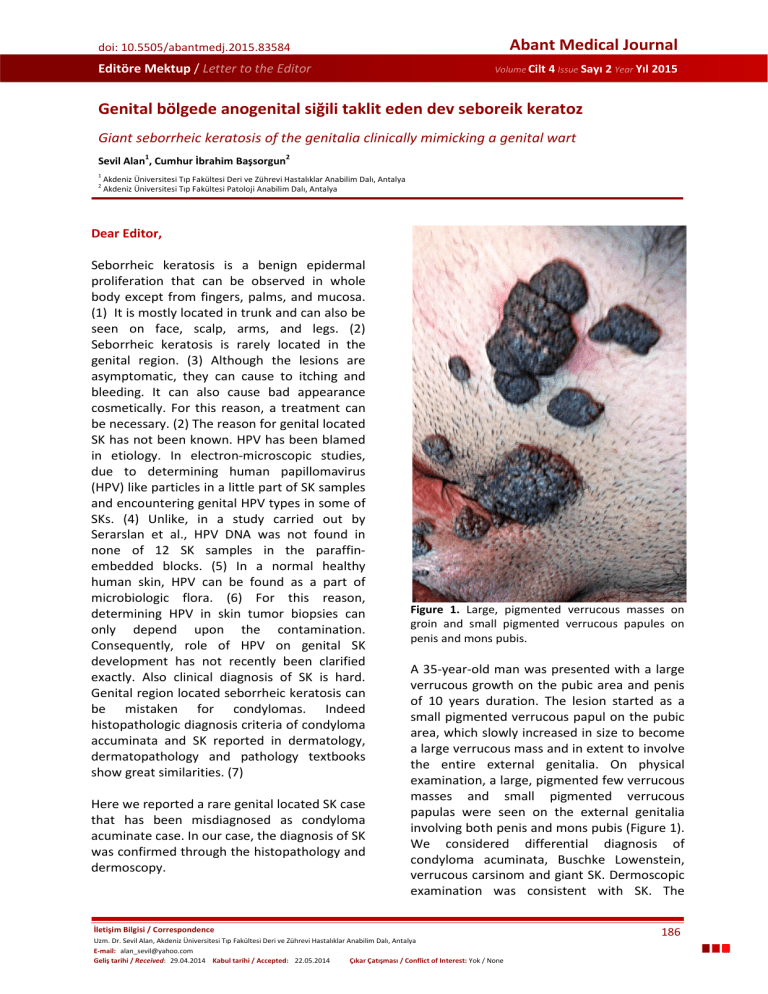
Abant Medical Journal
doi: 10.5505/abantmedj.2015.83584
Editöre Mektup / Letter to the Editor
Volume Cilt 4 Issue Sayı 2 Year Yıl 2015
Genital bölgede anogenital siğili taklit eden dev seboreik keratoz
Giant seborrheic keratosis of the genitalia clinically mimicking a genital wart
1
2
Sevil Alan , Cumhur İbrahim Başsorgun
1
2
Akdeniz Üniversitesi Tıp Fakültesi Deri ve Zührevi Hastalıklar Anabilim Dalı, Antalya
Akdeniz Üniversitesi Tıp Fakültesi Patoloji Anabilim Dalı, Antalya
Dear Editor,
Seborrheic keratosis is a benign epidermal
proliferation that can be observed in whole
body except from fingers, palms, and mucosa.
(1) It is mostly located in trunk and can also be
seen on face, scalp, arms, and legs. (2)
Seborrheic keratosis is rarely located in the
genital region. (3) Although the lesions are
asymptomatic, they can cause to itching and
bleeding. It can also cause bad appearance
cosmetically. For this reason, a treatment can
be necessary. (2) The reason for genital located
SK has not been known. HPV has been blamed
in etiology. In electron-microscopic studies,
due to determining human papillomavirus
(HPV) like particles in a little part of SK samples
and encountering genital HPV types in some of
SKs. (4) Unlike, in a study carried out by
Serarslan et al., HPV DNA was not found in
none of 12 SK samples in the paraffinembedded blocks. (5) In a normal healthy
human skin, HPV can be found as a part of
microbiologic flora. (6) For this reason,
determining HPV in skin tumor biopsies can
only depend upon the contamination.
Consequently, role of HPV on genital SK
development has not recently been clarified
exactly. Also clinical diagnosis of SK is hard.
Genital region located seborrheic keratosis can
be mistaken for condylomas. Indeed
histopathologic diagnosis criteria of condyloma
accuminata and SK reported in dermatology,
dermatopathology and pathology textbooks
show great similarities. (7)
Here we reported a rare genital located SK case
that has been misdiagnosed as condyloma
acuminate case. In our case, the diagnosis of SK
was confirmed through the histopathology and
dermoscopy.
Figure 1. Large, pigmented verrucous masses on
groin and small pigmented verrucous papules on
penis and mons pubis.
A 35-year-old man was presented with a large
verrucous growth on the pubic area and penis
of 10 years duration. The lesion started as a
small pigmented verrucous papul on the pubic
area, which slowly increased in size to become
a large verrucous mass and in extent to involve
the entire external genitalia. On physical
examination, a large, pigmented few verrucous
masses and small pigmented verrucous
papulas were seen on the external genitalia
involving both penis and mons pubis (Figure 1).
We considered differential diagnosis of
condyloma acuminata, Buschke Lowenstein,
verrucous carsinom and giant SK. Dermoscopic
examination was consistent with SK. The
İletişim Bilgisi / Correspondence
Uzm. Dr. Sevil Alan, Akdeniz Üniversitesi Tıp Fakültesi Deri ve Zührevi Hastalıklar Anabilim Dalı, Antalya
E-mail: [email protected]
Geliş tarihi / Received: 29.04.2014 Kabul tarihi / Accepted: 22.05.2014
Çıkar Çatışması / Conflict of Interest: Yok / None
186
Alan ve ark.
histopathologic examination of a biopsy
sample showed hyperkeratosis, acanthosis,
and multiple horn cysts, which were also
consistent with SK (Figure 2).
Figure 2. The acanthosis that include basaloid cell
proliferation consisting of thick keratohyalin granules and a keratinized obturator structures drew
attention on analysis of the sections (Hematoxylineosin stain; original magnification, ×400).
HPV was determined on biopsy material
through the PCR method. In performed HPV
typing, HPV 6 and HPV 16, HPV 6 as the
dominant, were determined. Due to the HPV
positivity, 2 session 25% podophyllin was
applied to the case. Degrowth occurred in
lesions. Because there was no adequate
response, the patient was directed to plastic
and reconstructive surgery polyclinic for total
excision.
Abant Med J 2015;4(2):186-187
References
1.Thakur JS, Thakur A, Chauhan C, Diwana VK,
Chauhan DC. Giant pedunculated seborrheic
keratosis of penis. Indian J Dermatol 2008; 53(1):
37-8.
2. Livaoglu M, Karacal N, Gücer H, Arvas L. Giant
genital seborrheic keratosis. Dermatol Surg 2007;
33(11): 1357-8.
3. Tardío JC, Bancalari E, Moreno A, MartínFragueiro LM. Genital seborrheic keratoses are
human papillomavirus-related lesions. A linear array
genotyping test study. APMIS 2012; 120(6): 477-83.
4. Gushi A, Kanekura T, Kanzaki T, Eizuru Y.
Detection and sequences of human papillomavirus
DNA in nongenital seborrheic keratosis of
immunopotent individuals. J Dermatol Sci 2003;
31(2): 143-9.
5. Serarslan G, Atik E, Otlu B, Bakariş S, Durmaz R.
Expression of cell proliferation markers in benign,
premalignant and malignant lesions and human
papillomavirus isolation. Turkderm 2007; 41(2): 5762.
6. Astori G, Lavergne D, Benton C, Ho¨ckmayr B,
Egawa K, Garbe C, et al. Human papillomaviruses
are commonly found in normal skin of
immunocompetent hosts. J Invest Dermatol 1998;
110(5): 752–5.
7. Li J, Ackerman AB. ‘Seborrheic keratoses’ that
contain human papillomavirus are condylomata
acuminata. Am J Dermatopathol 1994; 16(4): 398405.
187

